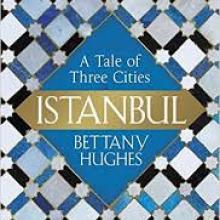
ISTANBUL: A TALE OF THREE CITIES
Bettany Hughes
Weidenfeld and Nicolson
By JIM SULLIVAN
Before you visit a city it pays to read about its past and, if Istanbul is on your itinerary, this is the book to read.
Historian Bettany Hughes is a fine storyteller and the triple biography of Byzantium, Constantinople and Istanbul is world history enmeshed in one desirable location. From the Greeks at Byzantium about 600BC to the Romans at Constantinople in AD300 to the Muslim city of the 1500s onwards and the Istanbul of modern Turkey, the layers of history are excavated in fine detail.

Along the way dozens of intruders found their way to this spot, which guards the entrance to the Black Sea. Persians, Vandals, Goths and the Crusaders all made their mark at various times and the modern city bears traces of them all. The author digs deep to find what they left behind and explain where the signs of the city's centuries of invasion can be found.
The era of Christian and Muslim conflict meant Constantinople was a goal to be held and then, as the capital of the ever-expanding Ottoman territories, the city became the engine room of a great empire. The luxury and excesses of the sultanate and the richness of a multicultural melting pot, exotic and mysterious to Europeans, is vividly portrayed in the book's fine illustrations.
Constantinople and its history evoked a world which artists and writers dreamed of and an extract from W.B. Yeats' Sailing to Byzantium is used as an appropriate introduction to the saga of the city: "Of hammered gold and gold enamelling/To keep a drowsy Emperor awake;/or set upon a golden bough to sing/To lords and ladies of Byzantium/of what is past, or passing, or to come''.
We seldom hear the Turkish side of World War 1 and there is a poignancy in reading the story of Constantinople during the conflict. Food became short and there was no gas for street lighting. One expedition against the Russians in the Caucasus resulted in only 18,000 men returning from a force of 100,000 and, at Gallipoli, 90,000 Turks were killed, twice the number of Allied fatalities.
Packs of war orphans found refuge in Constantinople's mosques and when peace came it was the only belligerent capital city to be occupied by the Allies. Pilgrims to Anzac commemorations will be told that from the heights of Chunuk Bair the survivors of that ill-fated attack could have seen the Dardanelles and in the far distance perhaps glimpsed Constantinople. That is as close as they got to the Turkish capital.
From defeat emerged the spirit that led to the founding of modern Turkey. The city became Istanbul and the capital moved to Ankara but it is Constantinople which draws the tourists, who will need a modern guide book to bring the story entirely up to date.
Still, with a flight time from Dunedin to Istanbul taking well over 24 hours, the 800 pages of Istanbul: A Tale of Three Cities will whet the appetite for this amazing city and distract from the tedium of air travel nicely.
Jim Sullivan is a Patearoa writer.












